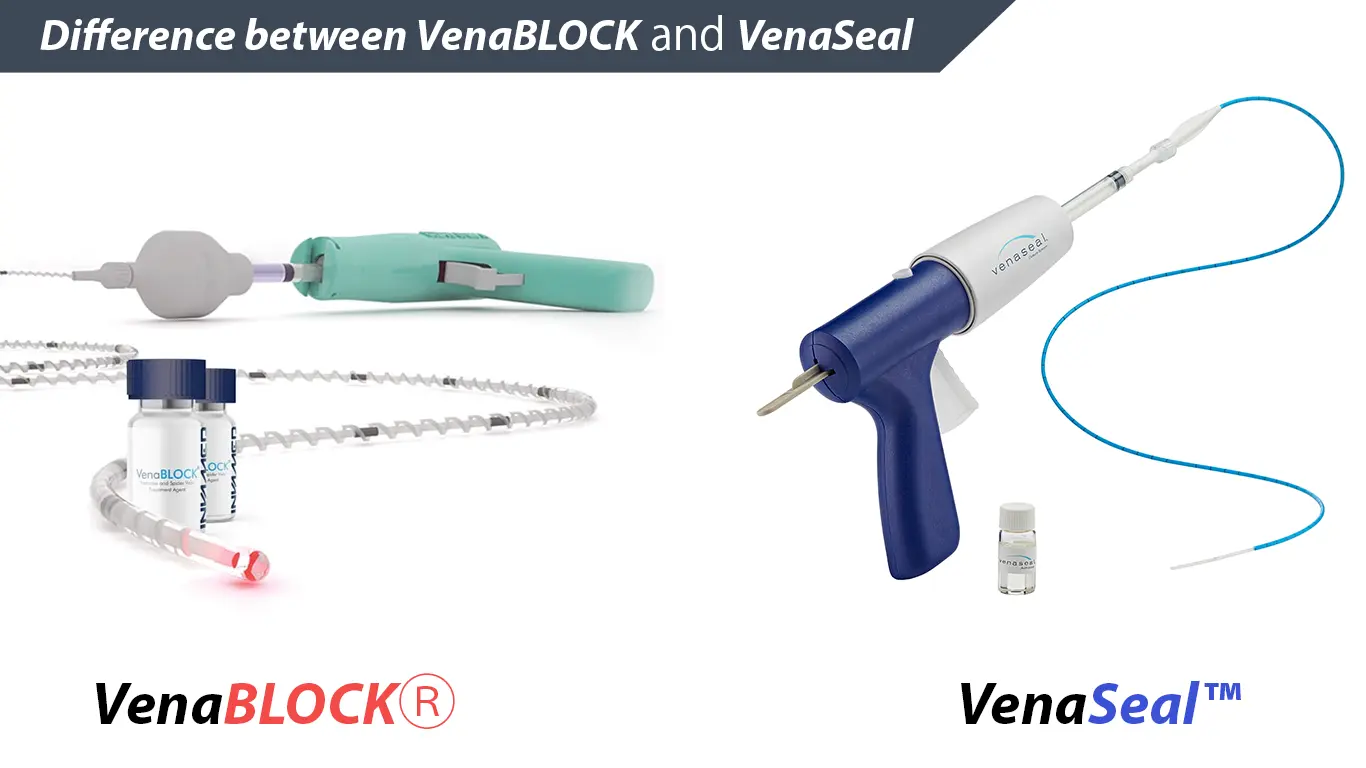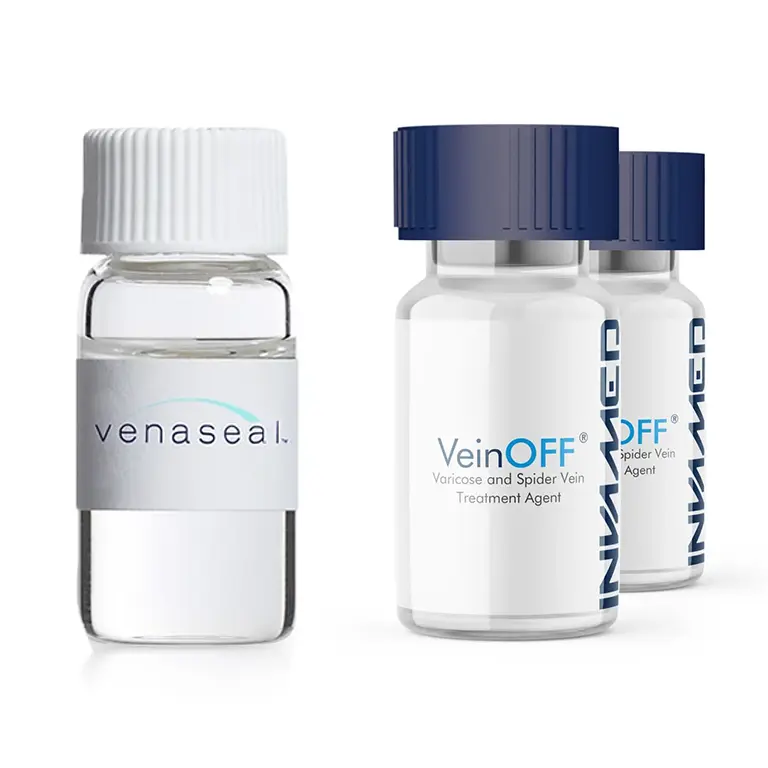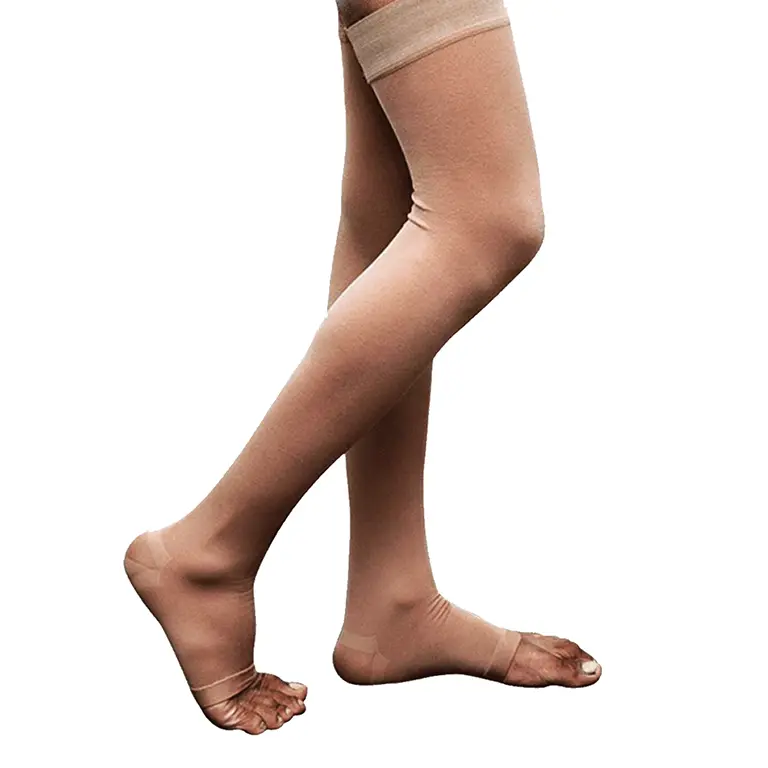Know more about VenaBLOCK and VenaSeal Treatment procedures for Varicose Veins.

VenaBlock and VenaSeal are two modern treatment options for chronic venous insufficiency, specifically targeting varicose veins. Both treatments are designed as minimally invasive procedures and offer an alternative to traditional surgical options such as vein stripping. They are part of the broader category of endovenous treatments, utilizing adhesive mechanisms to close off malfunctioning veins.
VenaBLOCK®
VenaBlock is a relatively new adhesive-based varicose vein treatment. It utilizes a biocompatible adhesive to seal the affected vein. This treatment prevents blood from flowing through the damaged vein, forcing it to reroute through healthier veins, eventually causing the blocked vein to shrink and be reabsorbed by the body.
Mechanism: VenaBlock works by delivering a medical-grade adhesive also known as Turkish Glue into the vein using a catheter, which results in the closure of the vein. The adhesive is designed to solidify quickly, ensuring the vein is sealed effectively.
Procedure: It is an outpatient procedure that generally takes about 30 minutes. The procedure involves minimal local anesthesia and is followed by immediate ambulation.
Post-treatment care: VenaBlock often requires less compression therapy post-procedure compared to thermal ablation or surgery. The patient typically wears compression stockings for a shorter period or none at all, depending on the surgeon’s recommendation.
VenaSeal™
VenaSeal is a more established adhesive-based treatment for varicose veins. Like VenaBlock, VenaSeal uses a specially formulated cyanoacrylate adhesive to close the damaged vein, forcing blood to reroute through healthier veins.
Mechanism: VenaSeal delivers a medical adhesive into the diseased vein using a catheter, which seals the vein shut. Once the vein is sealed, the blood naturally redirects to other healthier veins.
Procedure: Similar to VenaBlock, VenaSeal is performed as an outpatient procedure and takes around 30 to 45 minutes. The procedure involves only minimal anesthesia, and patients can return to normal activities quickly after the procedure.
Post-treatment care: One of the major advantages of VenaSeal is that it generally does not require post-procedural compression stockings, which increases patient comfort and compliance.
Similarities Between VenaBlock and VenaSeal
Procedure Type:
Both VenaBlock and VenaSeal are minimally invasive outpatient procedures. They utilize a catheter-based technique to deliver an adhesive directly into the damaged vein, sealing it off.
Mechanism of Action:
Both procedures use an adhesive to close off the varicose vein, which redirects the blood flow to healthier veins. Over time, the body reabsorbs the sealed vein.
Recovery and Anesthesia:
Both treatments involve minimal anesthesia (usually just local), and patients can generally resume normal activities immediately after the procedure.
Reduced Need for Compression Stockings:
While VenaBlock and VenaSeal differ in this aspect slightly, both procedures result in a reduced need for post-treatment compression stockings compared to traditional methods like thermal ablation.
Patient Comfort:
Both treatments are designed to enhance patient comfort by reducing pain, minimizing the need for compression, and eliminating the need for thermal energy, which can be associated with discomfort.
Outcomes:
Both VenaBlock and VenaSeal show high success rates for sealing varicose veins and improving symptoms related to chronic venous insufficiency.
Differences Between VenaBlock and VenaSeal

Adhesive Composition:
VenaBlock: Uses a biocompatible adhesive with properties specifically designed for this system. It is a newer technology in comparison to VenaSeal.
VenaSeal: Uses a proprietary cyanoacrylate-based adhesive, which is widely tested and approved for medical applications.
Market Presence:
VenaBlock: It is a newer product and thus may not be as widely available as VenaSeal.
VenaSeal: Established for a longer period and widely accepted as a safe and effective treatment for varicose veins. It has been more widely studied and tested in clinical trials.

Post-treatment Compression:
VenaBlock: May require short-term compression therapy depending on the patient and the extent of the varicose veins.
VenaSeal: Does not require compression stockings in most cases, making it more comfortable for patients post-treatment.
Pricing:
VenaBlock: As a newer option, pricing may vary and could be lower or higher depending on market conditions and geographic availability.
VenaSeal: Generally priced higher due to its established presence and reputation as a certified treatment with extensive clinical validation.

Clinical Evidence and Approvals:
VenaBlock: Limited long-term clinical data is available since it is newer on the market, but early results suggest effectiveness comparable to VenaSeal.
VenaSeal: VenaSeal has undergone extensive clinical trials and received numerous certifications, including FDA approval in the U.S. It has been validated as a highly effective treatment for chronic venous insufficiency.
Certifications and Approvals

VenaBlock:
As a newer treatment option, VenaBlock is undergoing clinical trials and is in the process of obtaining more comprehensive certifications. However, it is CE marked, meaning it complies with European Union health, safety, and environmental protection standards.
VenaSeal:
VenaSeal has received FDA approval in the U.S., ensuring it meets strict safety and efficacy standards for medical treatments. VenaSeal is also CE marked for use in Europe and other countries that recognize this certification. Additional certifications may be applicable depending on the country, such as approvals from local medical regulatory bodies.
Why we recommend VenaSeal?

We recommend VenaSeal over VenaBlock primarily because of its proven track record, clinical validation, and regulatory approvals. VenaSeal has undergone extensive clinical trials and has received FDA approval in the U.S., along with a CE mark for European use. This assures both safety and long-term efficacy, giving it a strong advantage over VenaBlock, which is newer and has less clinical data available.
Another key factor is post-treatment comfort. VenaSeal generally does not require patients to wear compression stockings after the procedure, enhancing convenience and reducing discomfort. On the other hand, VenaBlock may still require short-term compression therapy.
Finally, VenaSeal has been available for a longer period, making it a more widely trusted option in the medical community, while VenaBlock is still gaining market presence. For patients seeking a well-established, reliable treatment, VenaSeal stands out as the more proven and comfortable choice.
Why experiment when you can trust VenaSeal?
Proven, safe, and no need for compression stockings. Make the better choice today!
Fill the form to Get a Call Back
Our patient coordinators will contact you on your phone number with more details.
